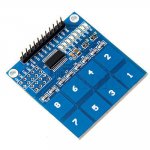So I went balls out on a project for work utilizing the touch feature of the 20m2, basically three buttons (copper wire strands rolled into a circle) behind some plexi glass, I got some base readings and some button pressed readings and wrote some code.
Little did i know that all my readings will change by next day(project undisturbed) thus rendering the code useless. Plus ive read that using the other pins will also effect. I know i can run calibration every so often but the issue is how often and what if a button is pressed during?
Has anyone dealt with this issue?
I have some ardunio pro minis and those offer a similar function using a input pin + output pin + resister has anyone worked with those and does the reading change in the same way ?
Little did i know that all my readings will change by next day(project undisturbed) thus rendering the code useless. Plus ive read that using the other pins will also effect. I know i can run calibration every so often but the issue is how often and what if a button is pressed during?
Has anyone dealt with this issue?
I have some ardunio pro minis and those offer a similar function using a input pin + output pin + resister has anyone worked with those and does the reading change in the same way ?

